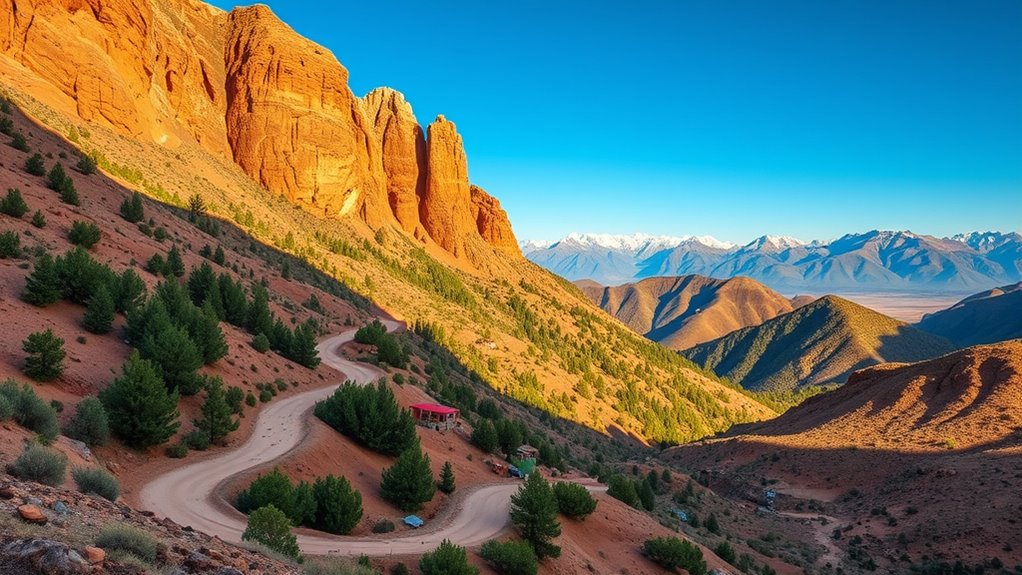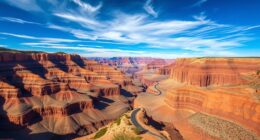Morocco’s Atlas Mountain routes offer an incredible mix of scenic drives, rugged passes, and vibrant villages. You can travel through iconic spots like the Tizi N’Tichka Pass, explore Berber villages, or hike up Mount Toubkal, North Africa’s highest peak. Stunning valleys, gorges, and lakes await, showcasing the country’s natural beauty and cultural heritage. If you want to discover the most breathtaking routes and hidden gems, there’s much more to explore along these mountain paths.
Key Takeaways
- Key routes include Tizi N’Tichka Pass, Azilal to Ouarzazate, and Imilchil Lakes Route, offering diverse scenic and cultural experiences.
- The Atlas Mountains feature traditional Berber villages, historic trade routes, and preserved cultural heritage throughout the region.
- Natural landscapes encompass rugged peaks, lush valleys, deep gorges like Dadès, and iconic geological formations.
- Popular activities include mountain trekking, scenic drives, exploring ancient villages, and visiting natural wonders like Toubkal and Dadès Gorges.
- Travel tips emphasize guided tours, suitable routes for various skill levels, and exploring the region’s scenic, cultural, and natural highlights.
The Tizi N’Tichka Pass: Morocco’S Mountain Gateway

Nestled high in the Atlas Mountains, the Tizi N’Tichka Pass serves as Morocco’s main gateway between the coastal plains and the interior. As you drive this winding mountain route, you’ll experience breathtaking views of rugged peaks and rolling hills. The pass connects Marrakech to the southeastern regions, making it an essential route for travelers and traders alike. Be prepared for sharp bends and changing weather conditions that add to the adventure. Along the way, small villages dot the landscape, offering glimpses of local life and traditional Berber culture. The route’s strategic importance has shaped Morocco’s history, and today, it remains a stunning gateway to explore the diverse landscapes and vibrant communities of the Atlas Mountains. Additionally, understanding the role of mountain passes in regional connectivity can deepen appreciation for the historical significance of this route, as these routes have historically facilitated trade and cultural exchange across remote areas. Recognizing how transportation infrastructure has evolved along such routes highlights their ongoing importance for regional development. Furthermore, modern improvements in road engineering enhance safety and accessibility for travelers navigating this challenging terrain.
The Valley of Aït Bougmez: The Happy Valley Experience
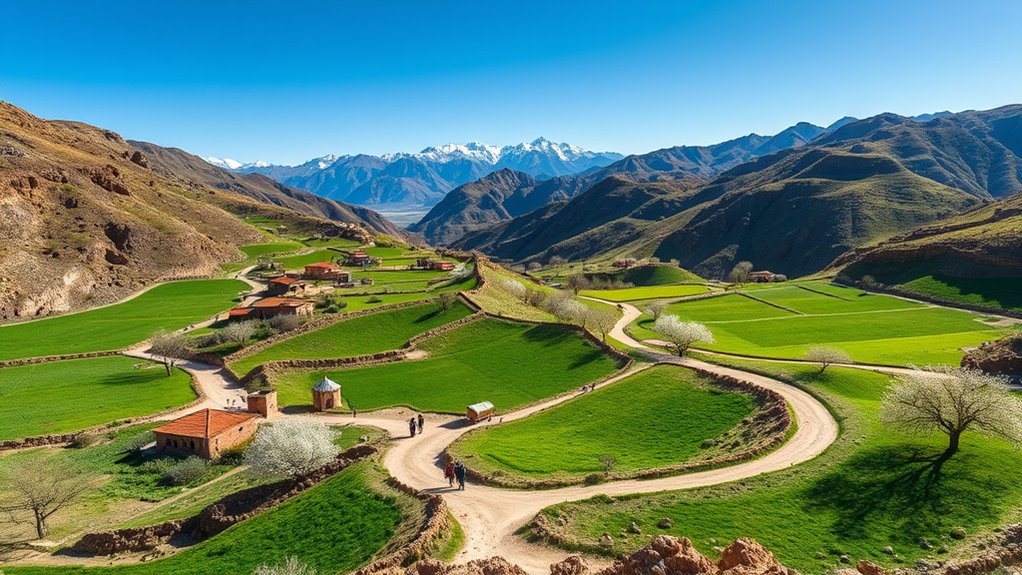
As you descend from the winding Tizi N’Tichka Pass, you arrive at the Valley of Aït Bougmez, often called the “Happy Valley” for its welcoming atmosphere and vibrant community life. Here, you’ll experience warm hospitality from locals who take pride in their traditions and crafts. The valley’s lush terraces, dotted with ancient villages, create a stunning landscape perfect for hiking, exploring, or simply soaking in the scenery. You can join villagers in their daily activities, enjoy fresh farm produce, or learn traditional Berber skills. The peaceful, friendly vibe makes it easy to connect with the land and people. This is more than a scenic destination—it’s a genuine encounter with authentic Berber culture and the joy of simple, sustainable living. Cultural immersion opportunities deepen your connection to the land and its people. Engaging with local artisans and their craftsmanship can enhance your understanding of traditional skills, fostering a deeper appreciation for the community’s heritage. Additionally, participating in local festivals or celebrations can further enrich your cultural experience and understanding of the community’s values. Recognizing the importance of community life in rural areas can provide a richer perspective on local customs and social bonds.
The Imilchil Lakes Route: A Romantic Highland Journey
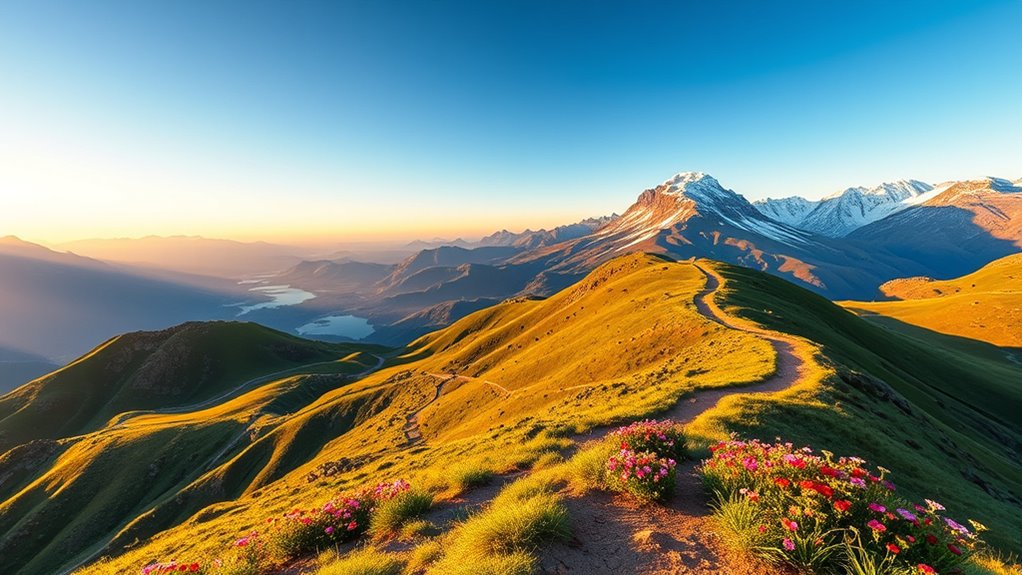
Beginning on the Imilchil Lakes Route offers a breathtaking Highland journey filled with romance and natural beauty. As you traverse the rugged mountain paths, you’ll be captivated by the shimmering blue lakes—Tsoutguine and Isli—nestled amidst dramatic peaks. The legend of these lakes adds a layer of enchantment, making your trip feel like a storybook adventure. You’ll pass through vibrant Berber villages, where locals welcome you with warm smiles and traditional music. The air is crisp, scented with pine and wildflowers, creating a perfect setting for reflection or shared moments. The route’s serenity invites you to slow down and enjoy the stunning vistas, making it an unforgettable, romantic escape into Morocco’s highlands. Incorporating scenic routes into your journey can enhance the experience further, offering spectacular views and peaceful surroundings. Engaging with the local culture can deepen your appreciation of the region’s rich history and traditions. Exploring the area can also provide insights into the region’s personal development opportunities through immersion in nature and tradition. Additionally, paying attention to newborn care guidelines while traveling can help ensure a safe and comfortable experience for families with infants.
The Ourika Valley: A Green Oasis in the Atlas
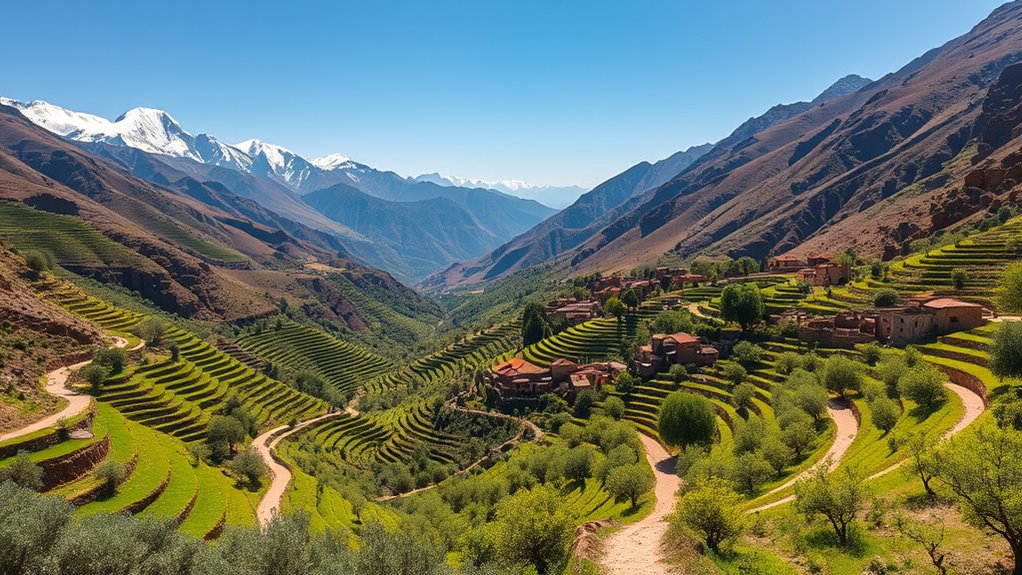
As you explore the Ourika Valley, you’ll notice lush green landscapes that stand out against the surrounding mountains. Small Berber villages dot the area, showcasing traditional ways of life. This vibrant oasis offers a peaceful retreat filled with natural beauty and authentic culture. Incorporating aesthetic wall organization solutions can enhance the visual appeal and functionality of local homes, reflecting the region’s appreciation for both beauty and practicality. Practicing mindful decluttering can also help preserve the area’s natural charm by reducing unnecessary clutter and waste, promoting sustainability for future generations. Embracing sustainable and eco-friendly decoration methods can also help preserve the area’s natural charm for future generations. Utilizing eco-conscious materials in local constructions and decorations can further support environmental preservation efforts.
Lush Green Landscapes
Nestled within the rugged Atlas Mountains, the Ourika Valley welcomes you with its vibrant, lush greenery that stands in striking contrast to the surrounding arid terrain. As you explore, you’ll notice terraced fields bursting with crops like strawberries, olives, and vegetables, revealing the valley’s fertile richness. The scent of blooming almond and cherry trees fills the air, creating an invigorating atmosphere. Waterfalls cascade down rocky slopes, adding to the valley’s vibrant scenery. You might pause beside the small streams and listen to the gentle rush of water, a soothing reminder of the valley’s abundant freshwater sources. This lush landscape not only sustains local life but also offers you a peaceful escape into nature’s vibrant beauty, making your journey through the Atlas Mountains truly unforgettable. Additionally, the fertility of the land is a testament to the valley’s importance as an agricultural hub, demonstrating how the nutritional value of local produce contributes to both local diets and the region’s economy. The presence of diverse natural resources in the area further enhances its significance for sustainable farming practices. Moreover, understanding the soil quality helps to appreciate the region’s capacity for supporting diverse crops and maintaining ecological balance.
Traditional Berber Villages
The traditional Berber villages of the Ourika Valley showcase a rich cultural heritage that has endured for centuries. As you explore, you’ll notice the distinctive adobe homes, terraced fields, and narrow winding streets that reveal centuries-old construction techniques. The villagers live simply, maintaining their customs, crafts, and agricultural practices. You might encounter local women weaving vibrant textiles or men tending to livestock. Visiting these villages, you get an authentic glimpse into Berber life, far from tourist hubs. The warm hospitality of the villagers invites you to share in their traditions and stories. These villages not only preserve history but also offer a unique, immersive experience that connects you directly with Morocco’s deep-rooted Berber culture.
The Azilal to Ouarzazate Road: Scenic Landscapes and Berber Villages

As you travel from Azilal to Ouarzazate, you’ll be treated to breathtaking mountain vistas that stretch endlessly. Along the winding scenic roads, you’ll pass through ancient Berber villages where traditions thrive. This route offers a perfect blend of awe-inspiring landscapes and cultural richness at every turn. For travelers seeking an authentic cultural experience, the route provides opportunities to connect with local artisans and learn about Berber heritage.
Breathtaking Mountain Vistas
Have you ever wondered what it’s like to drive through a living painting? As you navigate the Azilal to Ouarzazate road, towering mountains surround you, their jagged peaks piercing the sky. Vibrant green valleys stretch out below, dotted with terraced farms and winding rivers. The landscape shifts constantly, revealing dramatic cliffs, lush forests, and rugged canyons. Sunlight dances across the rocky surfaces, creating shifting shadows that highlight every contour. At every turn, breathtaking vistas unfold, inviting you to pause and absorb the raw beauty of the Atlas Mountains. This route offers more than just a drive; it’s a journey through an ever-changing tapestry of natural splendor that leaves you awe-inspired at every mile. The scenic landscapes are complemented by the charming Berber villages that add cultural richness to the stunning scenery. Exploring these villages provides a glimpse into local traditions that have been preserved over centuries, enriching your travel experience even further. Additionally, the route’s natural features showcase the diverse geology and ecology of the region, making it a haven for nature enthusiasts.
Ancient Berber Settlements
Driving through the Azilal to Ouarzazate route, you’ll encounter a tapestry of ancient Berber settlements nestled into the mountainside. These villages, often built with stone and adobe, have stood for centuries, preserving their traditions and way of life. As you pass through narrow, winding paths, you’ll notice terraced fields and small kasbahs that hint at a rich history. Berber communities here maintain their unique language, crafts, and customs, offering a glimpse into a resilient culture. Many villages are accessible only by rugged trails, emphasizing their seclusion. These settlements aren’t just scenic stops—they’re living pieces of history that connect you directly to Morocco’s indigenous roots. Visiting them provides a profound appreciation for Berber resilience amid stunning mountain landscapes.
Winding Scenic Roads
The Azilal to Ouarzazate road winds through some of Morocco’s most breathtaking landscapes, revealing a tapestry of rugged mountains, lush valleys, and terraced fields. As you navigate this scenic route, you’ll pass through charming Berber villages clinging to steep slopes, their stone houses blending into the landscape. The road twists and turns, offering stunning vistas at every bend—craggy cliffs, cascading waterfalls, and panoramic views of the High Atlas. You’ll feel immersed in the local culture, with opportunities to stop and explore traditional markets and meet welcoming villagers. The journey isn’t just about reaching Ouarzazate; it’s about experiencing the raw beauty and vibrant life of Morocco’s mountain heartland. Each mile brings new sights, sounds, and a sense of adventure.
The Mount Toubkal Ascent: Conquering North Africa’s Highest Peak
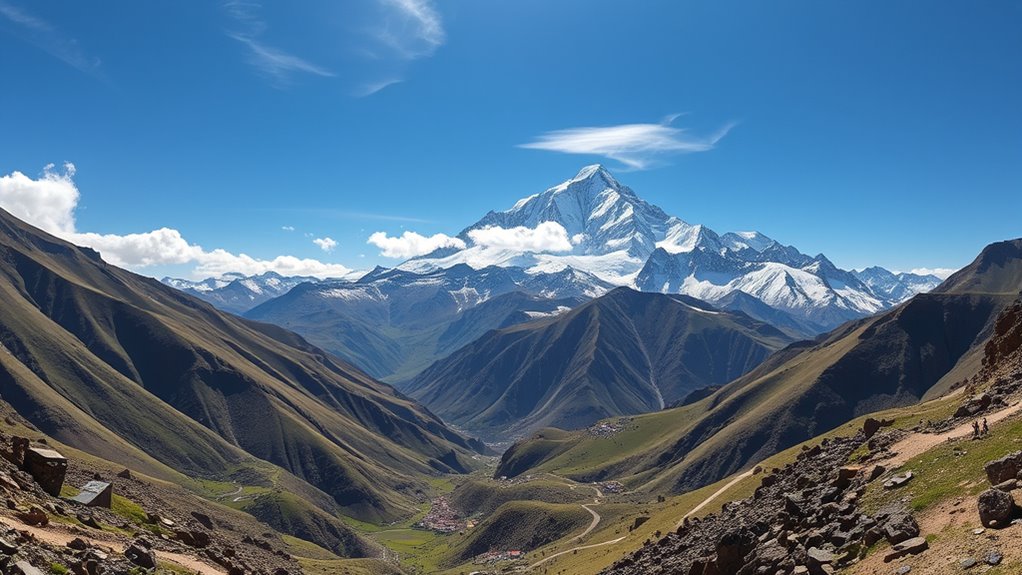
Climbing Mount Toubkal offers an exhilarating challenge for adventurers enthusiastic to reach North Africa’s highest peak. The trek begins in the charming village of Imlil, where you’ll acclimate before ascending. As you climb, you’ll navigate rugged trails, switchback routes, and rocky slopes, testing your stamina and resolve. Reaching the summit, at 4,167 meters, rewards you with panoramic views of the surrounding Atlas Mountains and the Sahara in the distance. To succeed, you should consider:
- Preparing physically for high-altitude trekking
- Acquiring local guides for navigation and safety
- Packing essential gear like layered clothing and sturdy boots
- Respecting local customs and environment during your journey
This ascent promises an unforgettable experience blending challenge, culture, and breathtaking scenery. Being aware of high-altitude health risks can help you better prepare for the physical demands of the climb. Additionally, understanding altitude acclimatization strategies can significantly improve your safety and comfort during the ascent. Recognizing the importance of mental resilience can also help you persevere through difficult sections of the climb. Regular air purifier maintenance and proper filter replacement can keep your environment clean and safe during your trip, especially if you are staying in accommodations that use air filtration.
The Dadès Gorges: A Spectacular Canyon Adventure
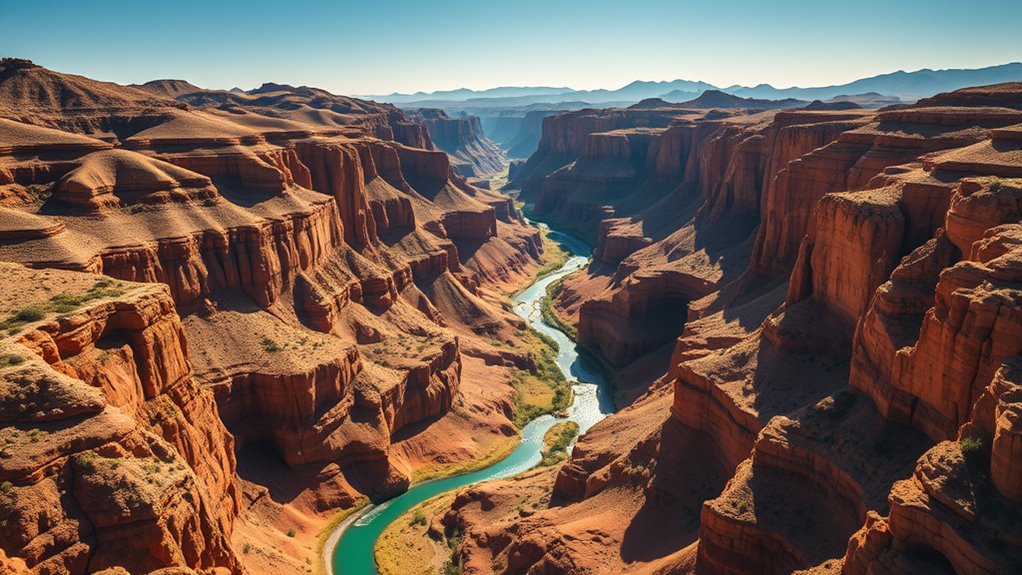
Nestled deep within Morocco’s Atlas Mountains, the Dadès Gorges offer a breathtaking landscape of towering cliffs, winding riverbeds, and dramatic rock formations that captivate every visitor. As you explore, you’ll feel the thrill of traversing narrow paths along sheer cliffs, with panoramic views unfolding around every bend. The gorge’s vibrant reds and ochres contrast sharply with the lush greenery of nearby oases, creating a stunning visual tapestry. You can hike along trails that follow the river, discovering hidden waterfalls and unique rock formations shaped by centuries of erosion. The air is filled with the scent of wild herbs, adding to the sensory experience. Exploring the geology of the area reveals unique rock formations that tell the story of natural forces at work over millennia. The presence of these formations highlights the geological history of the region, offering insight into the powerful natural processes that shaped the landscape. Whether you’re seeking adventure or serene vistas, the Dadès Gorges deliver an unforgettable journey through one of Morocco’s most spectacular natural wonders.
The Taroudant and Souss Valley Trails: Cultural and Natural Wonders

As you venture into the Taroudant and Souss Valley trails, you’ll discover a rich tapestry of cultural heritage and stunning natural landscapes. The area is dotted with ancient kasbahs, vibrant markets, and traditional villages that showcase Morocco’s history. You’ll also encounter lush olive groves, terraced fields, and rugged mountain terrain that highlight the region’s natural beauty. Along the way, you might explore:
- Historic mud-brick medinas and bustling souks
- Aromatic spice markets and handicraft stalls
- Serene palm groves and river valleys
- Mountain trails offering panoramic views of the Atlas and Sahara
This trail invites you to immerse yourself in authentic Moroccan life while enjoying breathtaking scenery at every turn.
Frequently Asked Questions
What Is the Best Time of Year to Explore Morocco’S Atlas Mountain Routes?
The best time of year to explore mountain routes depends on your preferences for weather and crowds. Generally, spring (March to May) offers mild temperatures and blooming landscapes, perfect for hiking and sightseeing. Fall (September to November) also provides cooler weather and fewer tourists. Avoid summer (June to August) if you dislike heat, as it gets hot and crowded. Winter can be snowy, ideal for certain activities but challenging for others.
Are Guided Tours Necessary for Hiking in the Atlas Mountains?
Guided tours aren’t strictly necessary for hiking in the Atlas Mountains, but they can enhance your experience. If you’re new to the area or unfamiliar with local terrain, joining a guide guarantees safety and helps you navigate better. Guides also share cultural insights and point out hidden gems. If you’re an experienced hiker and comfortable with navigation and planning, you might explore independently, but a guide adds comfort and local expertise.
What Safety Precautions Should Travelers Take on These Mountain Routes?
Imagine you’re hiking in the mountains when suddenly, a storm rolls in. To stay safe, you should always check the weather forecast before heading out, carry a map and GPS device, and wear appropriate gear. It’s also wise to hike with a guide, especially if unfamiliar with the terrain. These precautions help you avoid accidents and enjoy your adventure securely, no matter the unexpected challenges.
How Accessible Are These Routes for Travelers With Limited Mobility?
You might find these mountain routes challenging if you have limited mobility, as they often include uneven terrain, steep paths, and rugged sections. Accessibility varies, but many trails are not equipped for wheelchairs or mobility aids. To guarantee safety, consider guided tours with specialized equipment, or opt for more accessible routes nearby. Planning ahead and checking with local guides can help you enjoy the experience safely and comfortably.
What Local Customs Should Visitors Respect While Exploring Mountain Villages?
Like a delicate flower, local customs need gentle respect. You should greet villagers warmly with a handshake or a traditional “As-salamu alaykum,” and dress modestly to honor their traditions. Be mindful of local attitudes towards photography, asking permission before capturing people or sacred sites. When offered food or tea, accept graciously as a sign of respect. By embracing these customs, you build trust and enrich your cultural experience.
Conclusion
As you navigate Morocco’s Atlas Mountains, you’ll discover timeless beauty that feels like stepping into a living history. From the winding Tizi N’Tichka Pass to the majestic Toubkal summit, each route offers a unique adventure. Whether you’re exploring Berber villages or chasing waterfalls, you’ll find that these landscapes inspire and enchant—almost like a secret map hidden in plain sight. So, gear up and embrace the magic—your journey through these ancient mountains awaits.
